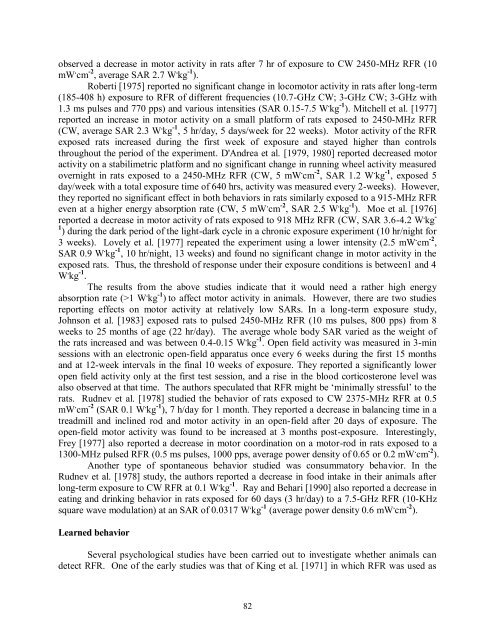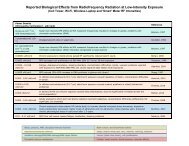Evidence for Effects on Neurology and Behavior - BioInitiative Report
Evidence for Effects on Neurology and Behavior - BioInitiative Report
Evidence for Effects on Neurology and Behavior - BioInitiative Report
You also want an ePaper? Increase the reach of your titles
YUMPU automatically turns print PDFs into web optimized ePapers that Google loves.
observed a decrease in motor activity in rats after 7 hr of exposure to CW 2450-MHz RFR (10<br />
mW . cm -2 , average SAR 2.7 W . kg -1 ).<br />
Roberti [1975] reported no significant change in locomotor activity in rats after l<strong>on</strong>g-term<br />
(185-408 h) exposure to RFR of different frequencies (10.7-GHz CW; 3-GHz CW; 3-GHz with<br />
1.3 ms pulses <strong>and</strong> 770 pps) <strong>and</strong> various intensities (SAR 0.15-7.5 W . kg -1 ). Mitchell et al. [1977]<br />
reported an increase in motor activity <strong>on</strong> a small plat<str<strong>on</strong>g>for</str<strong>on</strong>g>m of rats exposed to 2450-MHz RFR<br />
(CW, average SAR 2.3 W . kg -1 , 5 hr/day, 5 days/week <str<strong>on</strong>g>for</str<strong>on</strong>g> 22 weeks). Motor activity of the RFR<br />
exposed rats increased during the first week of exposure <strong>and</strong> stayed higher than c<strong>on</strong>trols<br />
throughout the period of the experiment. D'Andrea et al. [1979, 1980] reported decreased motor<br />
activity <strong>on</strong> a stabilimetric plat<str<strong>on</strong>g>for</str<strong>on</strong>g>m <strong>and</strong> no significant change in running wheel activity measured<br />
overnight in rats exposed to a 2450-MHz RFR (CW, 5 mW . cm -2 , SAR 1.2 W . kg -1 , exposed 5<br />
day/week with a total exposure time of 640 hrs, activity was measured every 2-weeks). However,<br />
they reported no significant effect in both behaviors in rats similarly exposed to a 915-MHz RFR<br />
even at a higher energy absorpti<strong>on</strong> rate (CW, 5 mW . cm -2 , SAR 2.5 W . kg -1 ). Moe et al. [1976]<br />
reported a decrease in motor activity of rats exposed to 918 MHz RFR (CW, SAR 3.6-4.2 W . kg -<br />
1 ) during the dark period of the light-dark cycle in a chr<strong>on</strong>ic exposure experiment (10 hr/night <str<strong>on</strong>g>for</str<strong>on</strong>g><br />
3 weeks). Lovely et al. [1977] repeated the experiment using a lower intensity (2.5 mW . cm -2 ,<br />
SAR 0.9 W . kg -1 , 10 hr/night, 13 weeks) <strong>and</strong> found no significant change in motor activity in the<br />
exposed rats. Thus, the threshold of resp<strong>on</strong>se under their exposure c<strong>on</strong>diti<strong>on</strong>s is between1 <strong>and</strong> 4<br />
W . kg -1 .<br />
The results from the above studies indicate that it would need a rather high energy<br />
absorpti<strong>on</strong> rate (>1 W . kg -1 ) to affect motor activity in animals. However, there are two studies<br />
reporting effects <strong>on</strong> motor activity at relatively low SARs. In a l<strong>on</strong>g-term exposure study,<br />
Johns<strong>on</strong> et al. [1983] exposed rats to pulsed 2450-MHz RFR (10 ms pulses, 800 pps) from 8<br />
weeks to 25 m<strong>on</strong>ths of age (22 hr/day). The average whole body SAR varied as the weight of<br />
the rats increased <strong>and</strong> was between 0.4-0.15 W . kg -1 . Open field activity was measured in 3-min<br />
sessi<strong>on</strong>s with an electr<strong>on</strong>ic open-field apparatus <strong>on</strong>ce every 6 weeks during the first 15 m<strong>on</strong>ths<br />
<strong>and</strong> at 12-week intervals in the final 10 weeks of exposure. They reported a significantly lower<br />
open field activity <strong>on</strong>ly at the first test sessi<strong>on</strong>, <strong>and</strong> a rise in the blood corticoster<strong>on</strong>e level was<br />
also observed at that time. The authors speculated that RFR might be ‘minimally stressful’ to the<br />
rats. Rudnev et al. [1978] studied the behavior of rats exposed to CW 2375-MHz RFR at 0.5<br />
mW . cm -2 (SAR 0.1 W . kg -1 ), 7 h/day <str<strong>on</strong>g>for</str<strong>on</strong>g> 1 m<strong>on</strong>th. They reported a decrease in balancing time in a<br />
treadmill <strong>and</strong> inclined rod <strong>and</strong> motor activity in an open-field after 20 days of exposure. The<br />
open-field motor activity was found to be increased at 3 m<strong>on</strong>ths post-exposure. Interestingly,<br />
Frey [1977] also reported a decrease in motor coordinati<strong>on</strong> <strong>on</strong> a motor-rod in rats exposed to a<br />
1300-MHz pulsed RFR (0.5 ms pulses, 1000 pps, average power density of 0.65 or 0.2 mW . cm -2 ).<br />
Another type of sp<strong>on</strong>taneous behavior studied was c<strong>on</strong>summatory behavior. In the<br />
Rudnev et al. [1978] study, the authors reported a decrease in food intake in their animals after<br />
l<strong>on</strong>g-term exposure to CW RFR at 0.1 W . kg -1 . Ray <strong>and</strong> Behari [1990] also reported a decrease in<br />
eating <strong>and</strong> drinking behavior in rats exposed <str<strong>on</strong>g>for</str<strong>on</strong>g> 60 days (3 hr/day) to a 7.5-GHz RFR (10-KHz<br />
square wave modulati<strong>on</strong>) at an SAR of 0.0317 W . kg -1 (average power density 0.6 mW . cm -2 ).<br />
Learned behavior<br />
Several psychological studies have been carried out to investigate whether animals can<br />
detect RFR. One of the early studies was that of King et al. [1971] in which RFR was used as<br />
82



